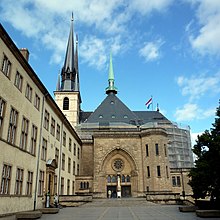| Cathedral of Our Lady Kathedral Notre-Dame Cathédrale Notre-Dame Kathedrale unserer lieben Frau | |
|---|---|
 Our Lady of Luxembourg | |
| Religion | |
| Affiliation | Catholic Church |
| Province | Archdiocese of Luxembourg |
| Ecclesiastical or organizational status | Cathedral |
| Status | Active |
| Location | |
| Location | Luxembourg City, Luxembourg |
| Geographic coordinates | 49°36′34.8″N 06°07′53.6″E / 49.609667°N 6.131556°E |
| Architecture | |
| Type | Church |
| Style | |
| Groundbreaking | 1613 |
| Completed | 1938 |




Notre-Dame Cathedral (Luxembourgish: Kathedral Notre-Dame, French: Cathédrale Notre-Dame, German: Kathedrale unserer lieben Frau) is the Catholic cathedral of the Archdiocese of Luxembourg, located in Luxembourg City in southern Luxembourg. It was originally a Jesuit church, and its cornerstone was laid in 1613. It is the only cathedral in Luxembourg.
The church is a noteworthy example of late Gothic architecture; however, it also has many Renaissance elements and adornments. At the end of the 18th century, the church received the miraculous image of Our Lady of Consolation (Latin: Sancta Maria Consolatricis Afflictorum), the patron saint of both the city and the nation.
Fifty years later, the church was consecrated as the Church of Our Lady and in 1870, it was elevated by Pope Pius IX to the Cathedral of Notre-Dame.
At the cemetery of the cathedral is the National Monument to the Resistance and to the Deportation. The centerpiece of the monument is the famous bronze monument by the 20th-century Luxembourgish sculptor Lucien Wercollier called The Political Prisoner.
The high altar of the cathedral enshrines an image of the Blessed Virgin Mary under the nationally venerated title of Our Lady of Consolation. The cathedral was expanded and enlarged from 1935 to 1938.